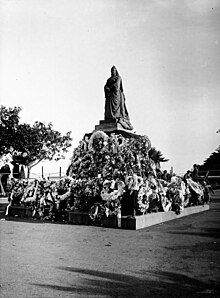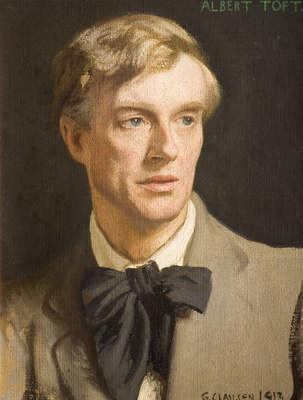
Albert Toft was a British sculptor.

Sir Joseph Edgar Boehm, 1st Baronet, was an Austrian-born British medallist and sculptor, best known for the "Jubilee head" of Queen Victoria on coinage, and the statue of the Duke of Wellington at Hyde Park Corner. During his career Boehm maintained a large studio in London and produced a significant volume of public works and private commissions. A speciality of Boehm's was the portrait bust; there are many examples of these in the National Portrait Gallery. He was often commissioned by the Royal Family and members of the aristocracy to make sculptures for their parks and gardens. His works were many, and he exhibited 123 of them at the Royal Academy from 1862 to his death in 1890.
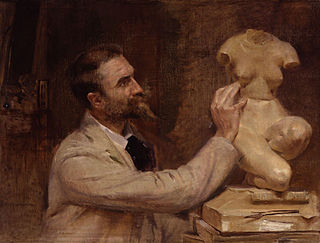
Edward Onslow Ford was an English sculptor. Much of Ford's early success came with portrait heads or busts. These were considered extremely refined, showing his subjects at their best and led to him receiving a number of commissions for public monuments and statues, both in Britain and overseas. Ford also produced a number of bronze statuettes of free-standing figures loosely drawn from mythology or of allegorical subjects. These 'ideal' figures became characteristic of the New Sculpture movement that developed in Britain from about 1880 and of which Ford was a leading exponent.

Albert Square is a public square in the centre of Manchester, England. It is dominated by its largest building, the Grade I listed Manchester Town Hall, a Victorian Gothic building by Alfred Waterhouse. Other smaller buildings from the same period surround it, many of which are listed.

The Victoria Memorial is a monument to Queen Victoria, located at the end of The Mall in London by the sculptor Sir Thomas Brock. Designed in 1901, it was unveiled on 16 May 1911, though it was not completed until 1924. It was the centrepiece of an ambitious urban planning scheme, which included the creation of the Queen’s Gardens to a design by Sir Aston Webb, and the refacing of Buckingham Palace by the same architect.
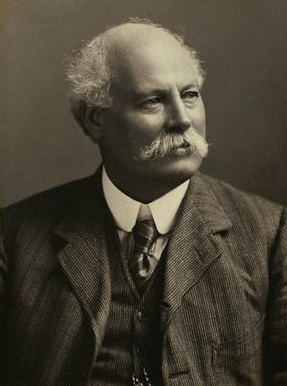
Sir Thomas Brock was an English sculptor and medallist, notable for the creation of several large public sculptures and monuments in Britain and abroad in the late nineteenth and early twentieth centuries. His most famous work is the Victoria Memorial in front of Buckingham Palace, London. Other commissions included the redesign of the effigy of Queen Victoria on British coinage, the massive bronze equestrian statue of Edward, the Black Prince, in City Square, Leeds and the completion of the statue of Prince Albert on the Albert Memorial.

John Henry Foley, often referred to as J. H. Foley, was an Irish sculptor, working in London. He is best known for his statues of Daniel O'Connell for the O'Connell Monument in Dublin, and of Prince Albert for the Albert Memorial in London and for a number of works in India.
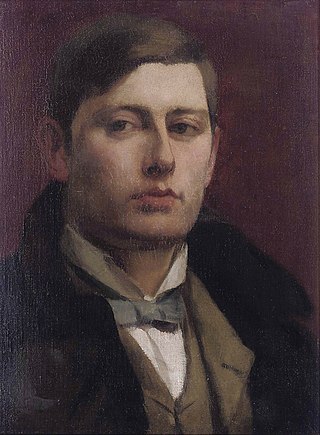
Sir George James Frampton, was a British sculptor. He was a leading member of the New Sculpture movement in his early career when he created sculptures with elements of Art Nouveau and Symbolism, often combining various materials such as marble and bronze in a single piece. While his later works were more traditional in style, Frampton had a prolific career in which he created many notable public monuments, including several statues of Queen Victoria and later, after World War I, a number of war memorials. These included the Edith Cavell Memorial in London, which, along with the Peter Pan statue in Kensington Gardens are possibly Frampton's best known works.

Albert Park is a public park in central Auckland, bounded by Wellesley Street East, Princes Street, Bowen Avenue and Kitchener Street. From the entrance at the corner of Bowen Ave and Kitchener St, sealed footpaths climb steeply through native trees to the large flat area at the summit, where a formal layout of paths and flower gardens encircle a fountain.
Edward Alfred Briscoe Drury was a British architectural sculptor and artist active in the New Sculpture movement. During a long career Drury created a great number of decorative figures such as busts and statuettes plus larger monuments, war memorials, statues of royalty and architectural pieces. During the opening years of the 20th-century he was among the foremost architectural sculptors active in Britain and in that period created the series of works in central London for which he is perhaps now best known. These include the figures on the Old War Office building in Whitehall, elements of the facade of the Victoria and Albert Museum and four of the colossal statues on Vauxhall Bridge.

The Victoria Memorial is a large marble monument in the Maidan in Central Kolkata, having its entrance on the Queen's Way. It was built between 1906 and 1921 by the British Raj. It is dedicated to the memory of Queen Victoria, the Empress of India from 1876 to 1901.
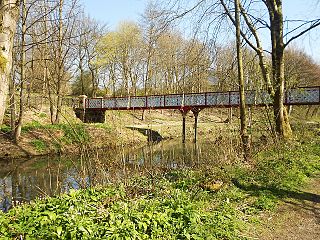
Queen's Park is a roughly circular 22 acres (8.9 ha) Victorian park lying on sloping ground to the north-west of Bolton town centre, in Greater Manchester, England. Opened as Bolton Park on 24 May 1866 by Lord Bradford it was renamed in 1897 in honour of Queen Victoria's Diamond Jubilee.

Francis John Williamson was a British portrait sculptor, reputed to have been Queen Victoria's favourite.

The Jubilee Memorial, Harrogate, is a Grade II listed building. It is a Gothic Revival stone memorial in Harrogate, North Yorkshire, England, commemorating the 1887 golden jubilee of Queen Victoria. It was donated to Harrogate by its mayor, Richard Ellis, designed by architect Arthur Bown, and unveiled by the Marquis of Ripon.
The Statue of Queen Victoria stands on the sea front at the bottom of Grand Avenue in Hove on the south coast of England. The statue is one of 14 by Thomas Brock and was unveiled in February 1901, the month after Queen Victoria's death. It is a grade II listed building.

Wellington's Queen Victoria Monument is an early 20th-century statue of Queen Victoria by British sculptor Alfred Drury. Copied after Drury's earlier 1903 Portsmouth statue, Victoria is depicted standing triumphantly in her Robe of State and widow's cap, holding a royal scepter and orb. The monument's plinth additionally features a plaque and three bronze reliefs, designed in the New Sculpture style, depicting the Treaty of Waitangi and various artistic and scientific inventions of the Victorian era.

The statue of Queen Victoria is a large bronze statue of Queen Victoria in Victoria Square, Christchurch. Sculpted by British artist Francis John Williamson, it was erected in 1903 as a monument to the Queen as well as the settlement of the Canterbury Province and a memorial to soldiers fighting in the South African wars.

The Sir George Grey Statue in Albert Park, Auckland commemorates George Grey, the third Governor of New Zealand and 11th Premier of New Zealand. The statue, sculpted by Francis John Williamson, was unveiled on 21 December 1904 by the Governor, William Plunket, 5th Baron Plunket.

The New Zealand Wars Memorial in Auckland commemorates imperial and Māori troops during the New Zealand Wars who were allied with British forces. The statue was commissioned by the Victoria League and sculpted by Thomas Eyre Macklin. The statue has been frequently subject to protests since its opening in 1920.


